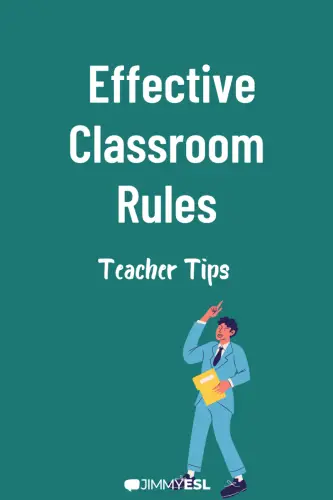Your Guide to ESL Classroom Rules for A Better Learning Environment
Is chaos in the classroom your worst nightmare? As a teacher, you, of course, know that rules are the key to a productive classroom environment and that both students and teachers must follow them to feel happy and fulfilled while in class.
But how do you make rules work practically and yet remain on friendly terms with your students?
Read this entry to find out about ESL classroom rules that may vary according to teacher’s goals and students’ age.
Importance of Classroom Rules
Learning Atmosphere
Both research and teachers’ experiences have proven that it is far more effective to build positive behaviors than to control students’ negative, defiant behavior. This illustrates that setting rules and sticking to them is the key to a pleasant learning atmosphere. Motivating students by giving rewards is one of the most effective ways to do so.
Academic Performance and Social Behavior
As a result, students’ academic performance and social behavior improve while the professional progress of teachers grows. But to set and react to a rule, it is necessary to build it on a routine that will support it.
Routines and rules go hand in hand, and consistent routine patterns are the pillars of rules respected. For example, if one of your rules in class is “No mobile phones in class!” you have to make sure that you have introduced an understandable and easy-to-follow procedure that supports this rule.
In other words, you explain to students that the use of mobile phones distracts their attention in class, so they are asked to leave it upon arrival in their pocket on the hanging chart. This way, students will feel respected and more willing to cooperate in the classroom environment.
The same goes for online classes. Rules like “Always turn your camera on” should be supported by a solid explanation and routine that students could easily rely on, like reporting attendance at the beginning of each class.
Routines and rules rely on two imperatives: consistency and predictability.
The classroom is a complex, challenging environment. So as a teacher, you should try to make it simple by informing your students about what they should expect, what is expected from them, and what behavior is acceptable.
By introducing routines in class, students and teachers learn how to manage their daily tasks and smoothly transit between activities, which will strengthen their coping skills when unexpected changes or disruptions occur. It will also reduce stress for you, since you don’t have to manage too many things at once.
Faster Learning Process
Once properly taught and regularly practiced for a certain time, following routines and respecting rules in the classroom comes naturally and needs only occasional assistance.
This brings benefits to both students and teachers. On the one hand, students get more opportunities to learn, and, on the other hand, teachers have more time to give effective instructions and follow up on students’ progress in the learning process.
Classroom Example
Meet Ron, an ESL teacher of different grade levels.
Today, Ron and his students were greeting and preparing for class. Ron was sitting on his desk, browsing through his materials for the day’s lesson, and just shortly said “Hello!”, when a student would enter the classroom. Just before the class began, some students were chatting, others were texting and almost everyone’s desks were empty.
When Ron started the class, he had to waste extra time making students quiet and taking their mobile phones away. On the wall of the classroom, a Rules Chart was hung, which included rules like, “Prepare books before class starts!” and “No mobile phones in class!”.
Now meet Robin, an ESL teacher of multiple grade levels, whose classroom is located opposite Robin’s.
That same day, Robin went to his classroom before his classes had started, prepared his teaching materials, then waited outside by the door to greet his students upon arrival. As each student approached, they first did a “high-five” with Robin and said “Hello. How are you today?”, Robin replied, “Hello. I’m fine, thank you.”, then enter the classroom and place their mobile phones in the pocket on the hanging chart marked with their name.
Next, they’d take their seat and lay their books and stationery on the desk. “We’re ready to start.” said Robin, and so a new ESL class began.
What’s the difference between these two scenarios?
Robin’s story speaks of positive rules management in the classroom while Ron’s scenario shows what happens in the classroom when there are no rules, i.e. when rules are just nominal but not implied.
Rules are the imperative of a productive classroom environment, and it is equally important for students and teachers to follow them to feel happy and fulfilled while in class. Understandably, ESL classroom rules may vary according to teacher’s goals and students’ age.
What To Do When Rules Are Broken?
Even the best students and teachers break rules from time to time, and that’s fine. Teaching is an organic process full of unpredictable events and behavior, so instead of striving toward flawlessness, consider upgrading your communication strategies and mechanisms. Rules are conditioned by appropriate consequences and rewards that you ought to design in parallel to the rules.
As a teacher, you’ll often encounter situations with obviously defiant behavior and in that case, a warning or consequence must follow. Nevertheless, you may also see students who fail to demonstrate the expected behavior due to exceptional events or misunderstandings.
In these situations, it’s essential to stick to the rules for the sake of the classroom community, but also show a rational understanding of the situation.
Exceptions to the Rules
The truth is, if you never bend the rules, your class atmosphere will become boring. Make sure you don’t let things go out of control, but show trust and respect to your students in certain situations and let them have fun from time to time.
For example, inform students that the rule “Never shout in class!” can be broken when playing games or that the only time when they’re allowed to change seats without asking are during group activities. Make sure you give out this information before you begin with activities to prevent misunderstandings.
Examples of Classroom Rules and Tips on Implementation
In the ESL classroom, the age and the level of language proficiency will determine the way routines and rules will be constructed and assessed.
Your main objective as a teacher is, however, to make sure everyone acquires the same high-quality English language learning.
Here are some examples of rules that you can add to improve the language
skills of your students and boost their confidence while learning a foreign language.
Communicate in English While in Class
Encourage your students to communicate in English before using their native language. Tell them that they have to use English for daily questions and statements like:
- What date is it today?
- Sorry, I’m late. May I come in?
- May I go to the restroom?
- May I ask you a question?
- Can you spell that, please?
- Can I borrow your pencil?
Always give classroom instructions in English and monitor students’ responses. For example:
- Open your textbooks on p. 15.
- Please read the text.
- Leave the homework notebooks on my desk, please.
This YouTube video will help you to do so.
Don’t Laugh When Other Students Make Mistakes
The learning environment in the ESL classroom must be positive, so students can progress and don’t feel uncomfortable when making mistakes while misspelling words in writing or mispronouncing while reading. Explain to students that mistakes are a normal part of the learning process and that ridiculing others will not be tolerated as it shows unkindness.
Raise Your Hand to Speak! Don’t Interrupt!
Tell students that when they are kind and respect their teacher and their classmates, that means that they respect themselves too. Explain that it is vital that every person in the class has a chance to speak without being interrupted and have the others listening carefully.
Take at Least One Turn in Activities in Class
This rule will activate and encourage students who are timider or feel insecure to speak in front of the class during solo or group activities. Inform students that their activity is very important for their learning and their grades.
You Mustn’t Use Phones in Class
We’ve already discussed this rule and explained it above. However, it still deserves to be pointed out as one of the top rules, as you do want to retain students’ attention. Also, you can use this rule to explain and practice the grammar form of the verbs “must” and “mustn’t”.
Examples of Rules for Distance Learning
When it comes to rules in the digital classroom, we can conclude that effectively built routines have an equally positive effect as those in physical learning environments. Although online learning may seem harder to control as there is no physical contact, however, you can try to make a simple order of rules for students to follow to make sure the class runs smoothly.
Create a list of rules and email it to your students at the beginning of the school year, or send them a link to this video.
Be On Time
Tell students that they should sign in to the teaching platform at least 10 minutes before class starts, so they can all start the lesson together.
Turn Your Camera On
Another rule that we mentioned above but equally important to be stressed again. Explain to students that they must have their camera on so that you can confirm their presence in class, and you can all see each other.
Do Not Eat or Drink
Need to say more? Just explain that, just like when in school, eating and drinking is something that they should do before class or during recess but never during online sessions.
Dress Appropriately
Explain to students that online classes are just like any other tête-à-tête classes, and that their PJs or a sports bra is not something they’d wear in school. Tell them to choose comfortable but representable clothes.
Mute Your Mic
Tell students to keep their microphones on mute unless they need to speak. Explain that this will prevent crowded sounds and unwanted (often embarrassing) moments while in class.
Bonus: ESL Classroom Rules for Younger Students
The aforementioned rules apply to students of all ages. However, when it comes to younger students, you must be extra careful when designing rules and expectations in the ESL classroom.
Younger students still haven’t developed consistent social behavior and are not mature enough to fully understand the implications that follow when a rule is respected or broken.
Therefore, you should avoid applying consequences when students of this age group break rules, but rather develop an approach with positive reinforcement that will illustrate what is “right” or “wrong” to do.
For example, you have to be flexible when it comes to “Communicate in English while in class” and encourage only simple use of language in the classroom.
Also, try saying things like, “We did an outstanding job for raising our hands to speak today. We are a class of kind and good friends.”
Wrap up
It is very easy to talk about rules, but it’s a different story to apply them effectively and make them work. Every class is different, and every teacher knows their class best, so it takes time, trust, and understanding finding the approach that is best for you.
Lastly, regardless of the strategy, remember to keep consistency between your expectations, the responses from your students, and your feedback.






